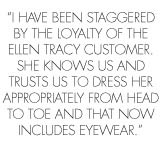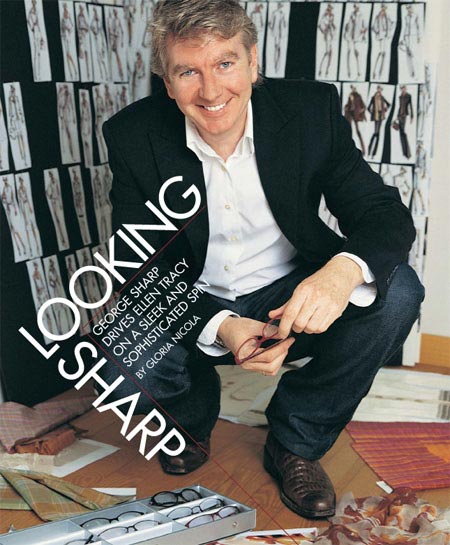|
Photographed by MARGARET GIBBONS
Appointed vice president of design for Ellen Tracy in April 2005, British-born George Sharp brings more than 20 years of experience to the iconic American ready-to-wear brand.
Holding various design positions during his career, Sharp has been involved in fabric development/ research, concept development and design, illustration, fitting and checking of garments and the selling and styling of the final collection. He became involved in fashion by default. “I went to school in Manchester, England to study art, but the fashion students seemed to be more fun and have better parties, so I switched to fashion,” he laughs. In 1983, his final year in college, Sharp created his own collection called Armstrong Collins Sharp, sold in upscale stores in London and his own freestanding store.
His various jobs in the fashion world included head of Escada, the Munich, Germany-based fashion house, a position he assumed in 2001. At Escada, Sharp had extensive interaction with such American retailers as Neiman Marcus and Saks Fifth Avenue, excellent experience for his current design position at Ellen Tracy, an all- American label founded by Herbert Gallen in 1949 as a blouse company. The brand has since morphed into an American institution, now offering a complete wardrobe of day and evening clothes, and accessories for women, including eyewear and sunglasses under a licensing agreement with ClearVision Optical.
In fact, the Ellen Tracy brand was instrumental in initiating the concept of a total wardrobe for the working woman. Sharp has begun giving his own British twist—a luxed up look—to the line, without ever forgetting the Ellen Tracy customer. “The Ellen Tracy woman for me is a 40+ sophisticated, elegant woman, who is successful and confident. She loves fashion, but chooses trends carefully,” Sharp explains. “She never wants clothes to be costumey. She prefers understatement with subtle and refined details to anything too obvious or too literal. But she loves colors, prints, luxurious fabrics and impeccable fit. She is more about stealthwealth than conspicuous consumption. Our customers don’t like clothes that scream out a label. They just like people to think they’re well dressed,” the designer adds.
With the newest Ellen Tracy fashions, Sharp says there will be much more of a designer element— narrower waists, subtle pocket placements and refined embellishments. “It’s really all in the cut of the clothes,” he notes. “I’m a classicist and am happy to see the fashion pendulum swinging back in that direction. It looks so new and right to see a woman in a crisp white shirt and a great pair of pants or in a cashmere top belted over a perfectly fitting skirt.”
 Sharp feels the Ellen Tracy brand is ideal for him. “Their design philosophy has always reflected my aesthetics. Ellen Tracy is known for great, clean, modern American sportswear. I like clean, modern clothes for real women. Creating clothes is not just about runway shows,” he emphasizes. What impresses him most, though, is the brand loyalty. “I have been staggered by the loyalty of the Ellen Tracy customer. She knows us and trusts us to dress her appropriately from head to toe and that now includes eyewear.” Sharp feels the Ellen Tracy brand is ideal for him. “Their design philosophy has always reflected my aesthetics. Ellen Tracy is known for great, clean, modern American sportswear. I like clean, modern clothes for real women. Creating clothes is not just about runway shows,” he emphasizes. What impresses him most, though, is the brand loyalty. “I have been staggered by the loyalty of the Ellen Tracy customer. She knows us and trusts us to dress her appropriately from head to toe and that now includes eyewear.”
The designer also believes the new Ellen Tracy eyewear from ClearVision Optical reflects the overall brand philosophy. “The eyewear captures effortless styling mixed with bold colors, a luxurious feel and great quality—all things our customers embrace. The Ellen Tracy consumer doesn’t want to stand out in a crowd, but does want to be remembered,” Sharp explains. “Eyewear is a very personal decision because it’s an extension of personality. If pants don’t fit quite right, you might be able to get by with it. That’s not possible with eyewear. It’s right there on the face for everyone to see.”
Sharp feels current optical collections are much more expressive than they used to be because of new technology that allows for intricate details and innovative mixes of materials and colors. “I was pleasantly surprised at how receptive women are to colorful eyewear,” he says. “When I first saw the color palette for the Ellen Tracy line, I thought it was too bright. I guess I always envisioned eyewear in terms of black or tortoise. Then I started noticing women on the subway wearing colorful frames and they looked good.”
With new frame styles, ClearVision and Ellen Tracy are working on incorporating organic and global influences such as African and Aztec motifs, but still keeping the styles restrained and refined.
With ClearVision, we have a great partnership, Sharp explains. “The way they do things is similar to the way we work at Ellen Tracy. We like their interest in quality. They are nice people to work with and they produce nice products.” Whether it’s in eyewear or clothing, Sharp feels great style is not trying too hard. “Style comes from the confidence and comfort of wearing what you know looks best on you,” he says. “It’s making a look you own—not slavishly following trends.”
Sharp’s greatest sources of inspirations in his design work have been his wife and friends. “My wife is a stylist and has an amazing eye,” he notes. “I’m also a huge fan of the fashion designer Yohji Yamamoto. His work is incredible. And I admire Tom Ford. He made fashion sexy and inspirational because he was not afraid to be commercial. Commercial is not a dirty word. I love commercial.”
If not a designer, Sharp would like to be an architect. “I have more books on architecture than on fashion,” he notes.
“But for now, my charge is to dress Ellen Tracy customers 24/7—from the boardroom to the weekend,” the designer says. “We will modernize and update the look, but it will always be appropriate to the Ellen Tracy woman.”
|


